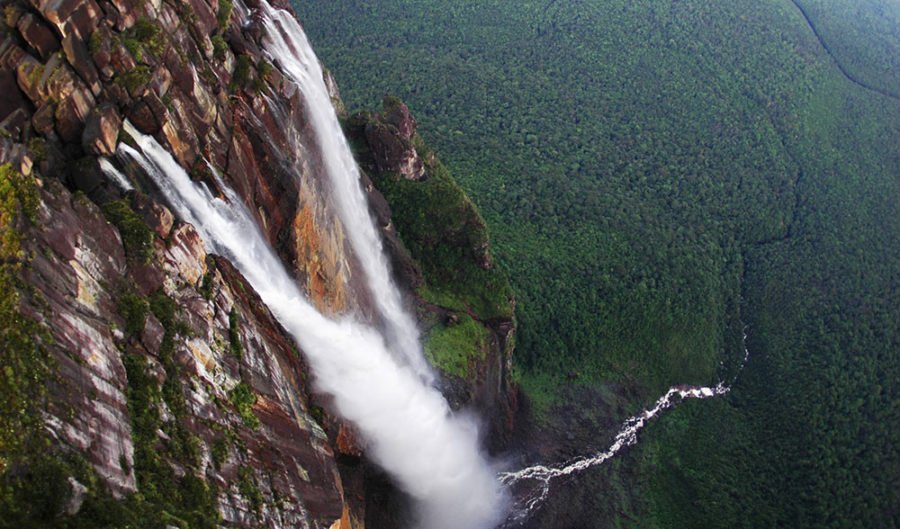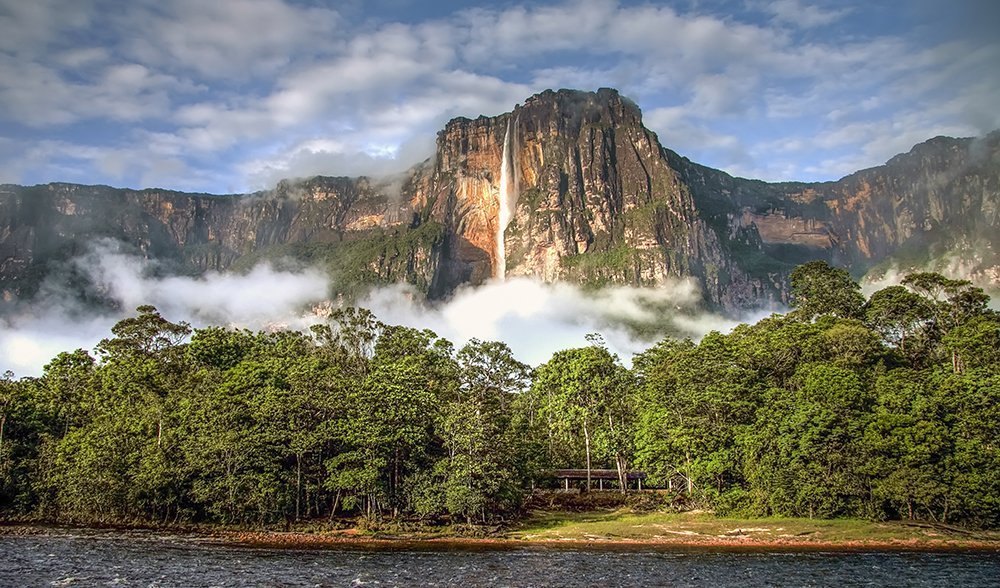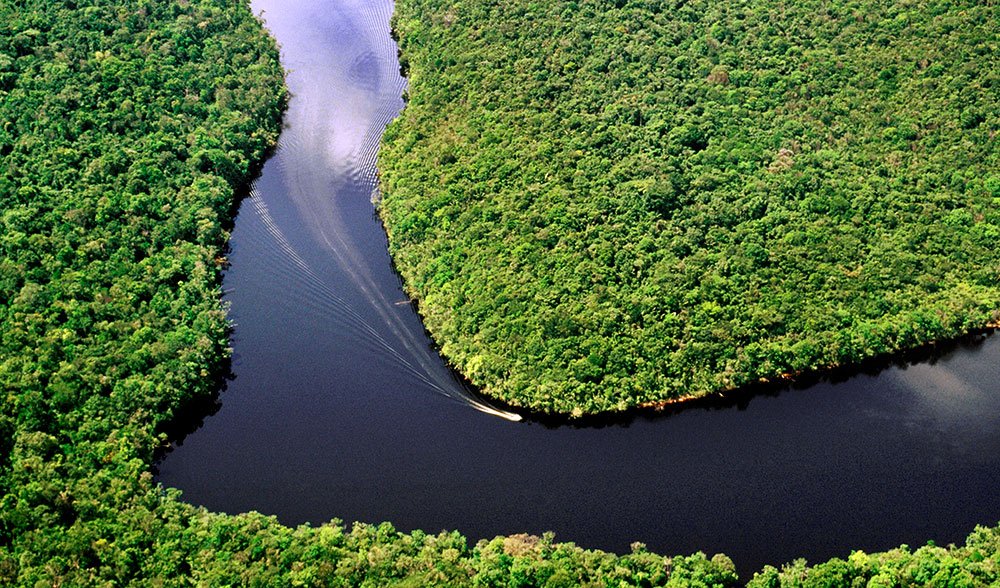Angel Falls, Venezuela

IT WAS WHEN the chicken came on board that we started to relax. It wasn’t yet 8am and we’d already been drenched in river spray in pearly pre-dawn light, seen our first tepuy (pronounced tar-poo-ey) and force-marched across a savannah island for 40 minutes. Our guide, Igberto, drove us mercilessly over the open ground; right up to the point when he saw some friends, and jogged over to their thatch-roofed open-air room for what we assumed was the Venezuelan early morning equivalent of a quick toke.
Back on the water, we’d failed our first attempt to take a rapido head on. Our helmsman had pointed the curiara (log canoe) at a metre-high cascade – and accelerated. We’d barely had time to realise what he was planning when the boat lifted skywards while a tannin-brown wave reared over the bow and landed in the boat. To enliven the experience we stalled mid wave and, in spite of the two crew who leapt overboard into neck-deep water, we proceeded to slip calmly backwards with the current to our start point. We were drenched and rather speechless, clinging to waterlogged bags, cameras and clothes. In the end, we disembarked and picked our way along the edge, while the crew took the canoe up with less weight.
Tribulations

Angel Falls is composed of 47 separate drops. Its jaw-slackening longest single drop of 807m is indisputably the world’s biggest. (Photo credit: Shutterstock.com)
“We’re going to Angel Falls,” we’d said excitedly to anyone who’d listen, in the weeks leading up to our trip. When met with blank stares, we reached for the memory-jogger: “Arthur Conan Doyle? The Lost World?” usually did the trick for mid-century inquirers, and for those in the Generation alphabet band: “You know, the Pixar movie Up? Where the guy in the balloon house goes?” Actually, the Venezuelan cascade, listed as the world’s highest with a plunge of 807m, looks a lot like that beautifully drawn animation. The region’s thick forests run from the river up steep slopes to sheer cliffs and then on to the flat-topped tepuys – substantial mountains that appear to have been unceremoniously beheaded.
It’s a landscape so dense and diverse that it’s like a botanical Mandelbrot: from a distance trees, on which grow succulents and ferns, on which grow mosses and creepers, on which grow small shoots of verdure, on which feed a dazzling array of bugs – and so on ad infinitum. It’s worth the effort to get there – an effort we thought we’d achieved after a three-day journey of planes, strains and automobiles that delivered us to the shores of Cainama Lagoon and the faded grandeur of Waku Lodge. Just one boat ride to go, and we’d reach the fabled falls, known hereabouts as Salto Angel.
“It’s a long day,” said our Waku host, Pablo, whose calm demeanour and proven ability to fix all problems instilled in us unquestioning faith. “And the men on board will have to push the boat through shallow sections because, right now, the water is low.”
Freshly saturated from an afternoon tour of Cainama Lagoon waterfalls, we had only one question: “But we’ll be mostly dry, right?”
“Of course,” said Pablo. “Take your cameras; it will be dry in the boat.”
Which is how we found ourselves drinking viscous, sweet coffee and pocketing comfort crackers at 4:30am, standing next to a haphazardly packed bag containing our best cameras – you only see Angel Falls once, right? – before being loaded bleary-eyed onto a converted open-air lorry to rattle and bump to our departure point on Rio Carrao. When we arrived, the stars still shimmered in the sky and the idyllic scene only improved when the peachy dawn unveiled the magnificent Amazon landscape. Then the tribulations began.
First came the spray, which rose mischievously from the bow like wings, floating across the entire ship’s company like spray paint. We glanced back at our fellow travellers – the garrulous Uruguayan trio of Walter, his wife Ana and their friend Alba, and the athletic and energetic Gabriella, a Venezuelan – to see if they were as sodden. Yes, they were.
Next came the forced savannah march – through sand, ants and an impressively bio-diverse collection of small bitey bugs – to reach the re-embarkation point past the rapidos Mapuya, which were already too low to safely transit. Then came the drenching courtesy of our failed rapid attempt and – 20 minutes later – the chook embarkation point.
We had slowed smoothly at a turn, and five mongrels (so well-fed and ubiquitous around Cainama) had come to the riverbank to bark a hearty greeting. The boat slowed, one of the crew leapt ashore and – fearing another toke-stop – Gabriella sighed, opened her backpack, withdrew a flattened Milky Way and offered clumps to her slightly jangled fellow passengers. We took note of the time, and were laughing about what we would be doing at this time of the morning in the real world, when Igberto arrived with his avian friend.
It was a fine specimen, lithe and lean, which was easy to see, as it had been smoothly plucked. It hung from the boatman’s hands by its recently wrung neck, its claws swaying insouciantly with the boat’s rocking. In response to our astonished looks, the boatman gave a toothy grin. “Desayunos [breakfast]?”
All about the journey

It’s about six hours up the Carrao (pictured) and Churun rivers by log boat to Angel Falls. (Photo credit: Shutterstock.com)
Visiting Angel Falls in November, when the rains have stopped and before the dry makes the river impassable by boat, requires a journey up current against shallow rapids and smooth quartz boulders. It’s bouncy, wet, jerky and fun. It would resemble white-water rafting – if you were white-water rafting upstream, in a front-heavy, hollowed-out log attached to an outboard motor, with a guy on the bow wielding a wooden object that’s a cross between a paddle and a lacrosse stick and shouting terse instructions at you in Martian.
This is why the chicken was so calming.
At first we thought that we’d put ourselves into the hands of a typical tourista-managed group tour, but the savannah march had pretty much killed that idea. After the abortive rapid attempt, we’d begun to worry that maybe, just maybe, we’d landed ourselves in a boat run by lunatics. The advent of the poultry signalled option number 3: these guys had a job to do. Coddling us was not on the agenda. They were going to get us up the drying river, see the icon and get us back. No one was going to die on their watch. Avoiding sunburn, minor injury, malnutrition, dehydration and misadventure by native animal was strictly a matter for us.
The river, as it turns out, is just like the Tully, except higher, warmer and in Spanish. At the clarion call of “para el agua” (into the water) all the men bail over the side and push. Outside the boat, the current is relentless, and the initiation for the chosen is a gung-ho splash, a grab of the boat and an almost immediate slip against the smooth, slippery river stones, at which point you know you’re playing for keeps. As your hand clenches whatever you can find that’s part of the boat, the rest of your body seeks to travel downstream, and as your torso debates the upstream-downstream dilemma, your feet somehow manage to convince themselves that it’d be better to move than stop.
If you lose your footing, the boatmen yell at you in local patois, something to the tune of “stand up and push, schmuck – this is no time to drown”. So you do. This is Latin America: go macho or go home. You grab a plank-seat, put your shoulder to the log, and use the weight of the boat to keep your feet anchored. And push – until they say “fuera” (shorthand for “back in the boat”). It’s only when you’re back in that you realise you’ve used a month’s worth of adrenalin. Your limbs are like wet washing and you’re gasping for air. Five minutes later you do it again.
For those inside the boat, a rapido push is a serene, meditative experience. When the rocks come, the engine is raised and the boat’s stationary at worst, or gently progressing at best, and over the top of the pushers’ whitened knuckles and damp hair, there’s a clear view of the verdant mosses draping the bank. Butterflies flutter past and the occasional neon blue dragonfly stops for an insect nap on an arm, hat or life jacket. The only noise is the cascading tannin water, and the occasional muttered expletive from beside the boat. It’d be the perfect time to take photos of the passing parade, if it wasn’t for the wild-eyed looks from the water-men towards the back of the boat and the alarming lurch from gunwale to gunwale as one by one they heave themselves back aboard.
And so it goes – onward ever onward, by buzzing outboard or bedraggled men we travel towards the falls, racing other curiara in a cheerfully competitive game of “eat my spume”, and passing the wounded and the fallen: a boat whose helmsman hasn’t lifted the outboard quickly enough wallows against the rocks, its propeller looking like a set of broken teeth; a log full of German passengers sit pensively upright as their bare-chested boatman duck dives around his sputtering motor.
As the river bends and weaves, the gnarled tepuy silhouettes morph into shadow puppet silhouettes. Along the bank the high-water mark draws a line well above our heads, and the trees stretch their epiphyte-covered branches across the river. Hummingbirds rocket in a series of straight-line paths, taking off in unexpected and very un-bird-like right angles as they outline their own invisible dodecahedron.
We glide past current-rounded rocks encased in a fluffy emerald green grass that looks inspired by one of the more lurid Muppets. Where the water flows over the trailing green it washes it into long glowing waves like mermaids’ curls. It’s utterly beautiful – and utterly beside the point. They say it’s all about the journey: whoever they are, they’ve clearly never wanted to see Angel Falls.
The shower of the gods

It’s all about water in Cainama National Park, home of Angel Falls and – downriver – the five cascades (above) that thunder into Cainama Lagoon. (Photo credit: Shutterstock.com)
From Cainama to the falls is 46km as the crow flies; the river’s twists and turns double that distance for us. Travelling by log on the cusp of the dry season, we’ve been folded in accordion shapes for more than six hours when we finally wash up near the base of Salto Angel and look up… and up… and up.
It’s so high that the eagles seem to soar at ankle height, so high that the water that streams off the top has evaporated by halfway down.
From the smooth, shining rocks up its dense pelt flanks to the point where the rock face makes a vertical break for it and reaches for the sky, and the tabletop flatness over which the water appears, only serve to add to a sense of impossibility to it.
It’s higher than Harry’s pants, higher than an elephant’s eye, higher than a snooty horse. It’s as high as the sky.
We decide to wash off the trip’s damp travails by – what else – going for a swim, and in our bathing pools in the shallow Rio Churun rapido we rest and lolligag and peer at our surrounds. Auyantepuy, from which the falls float, towers above us. All along this stretch of the Churun are rough bush camps that host Salto Angel overnighters: people who want to tumble out of a hammock to see the falls first thing in the morning. Now, with the wet season over, the camps are practically empty, and the riverbank forests are mostly populated by flitting birds and insects, the colours of which catch our eyes in passing. But every time we turn to follow their flight, we’re drawn to look at Salto Angel. In the same way Uluru exerts a magnetic force on every onlooker within a 20km radius, the falls can’t be ignored. It’s of the landscape and yet somehow greater than it – like Mount Rushmore, only many times the height and minus the sculpting scree. It’s the shower of the gods.
We could tell you about the serene trip back downriver, into the sunset under flocks of birds; about the “god’s finger” afternoon rays of light that broke through the clouds and spotlit the tepuys as we drifted by with the current; about the impossibly large starry sky as we lay back in the log as it flew over the water. Also about the macho full-forearm bruises that lasted a month; the post traumatic leg shakes that struck without warning in the following days; the dreams of mermaids that chased us across countries and time zones; and the sense of unalloyed adrenaline-fuelled joy that comes from surviving a journey both unexpected and surreal. But we won’t.
What we can tell you, though, is that eating spicy, juicy, freshly barbecued chicken and salad while gazing across the sweep of a golden river to a silver stream of water floating off the top of a buzz-cut tepuy is something to write home about. Really.
The Essentials
Getting there: There are direct flights to Caracas, Venezuela’s capital, from cities in the USA, Canada, Europe and South America. From Caracas you fly via Puerto Ordaz or Ciudad Bolívar to Canaima, the departure point for Angel Falls scenic flights and curiara – canoe – trips.
Access: River trips are best during June–December, when the waters run deep enough for canoes. The journey upstream takes 5–6 hours and it’s another hour’s walk to the base of the falls. You’ll get a better price on Angel Falls adventures if you buy in Venezuela (an official/unofficial exchange rate thing). Prices are said to be sharpest in Ciudad Bolívar, but you’ll do okay once in Cainama itself.
Climate: Tropical. There’s little temperature variation year-round – daily min/max ranges are low 20s to low 30s. The wettest months are July–October and the driest January–March.
More info: “Official” information (check www.venezuelaturismo.gob.ve) is rather thin. A specialist South American travel company – we used Chimu Adventures (www.chimuadventures.com) – is a good bet.
READ MORE:
- Inka Rivers Trek, Peru
- Explore paradise: Palau
- Lofoten, Norway
- Tropical North Queensland

